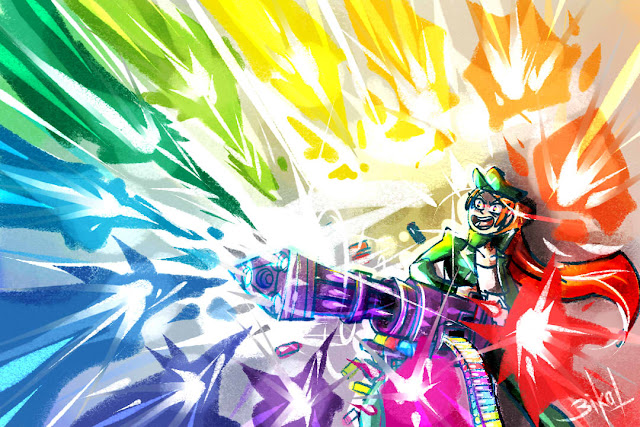FFA233 ( DIGITAL INK & PAINTING ) : PLOTTING LIGHT AND SHADES ( ADOBE PHOTOSHOP CS6 )
Subject : FFA233 W2 (Digital Ink & Painting)
Semester : FF115 III B
Exercise : Plotting light and shades (Adobe Photoshop CS6)
- MOST PRIMORDIAL OPPOSITES -

Credit: El Bovidae
I welcome you, our new assignment. And this week is a pretty simple, yet a little tricky assignment waiting for us which is called plotting light and shades.
We can see how light and shades work in our daily lives. As an artist, this two forces which are both need each other are those important things that we need to understand so that we could make more appealing art. It's actually very common for artists to treat light as an addition to the picture, an atmosphere-maker. With light and shades, we could also give the viewers the impression that the object has a universal form, and with proper lighting, we can also change the mood of the picture.
Well, as for today's class, we're going to learn to do just that, to add light and shades the right way. We started off by doing a little treatment on some pictures that are provided to us by Miss Sheila using Adobe Photoshop CS6.
The pictures: Interior I
Semester : FF115 III B
Exercise : Plotting light and shades (Adobe Photoshop CS6)
 |
| Rembrandt : The Holy Family At Night |
- MOST PRIMORDIAL OPPOSITES -

Credit: El Bovidae
I welcome you, our new assignment. And this week is a pretty simple, yet a little tricky assignment waiting for us which is called plotting light and shades.
We can see how light and shades work in our daily lives. As an artist, this two forces which are both need each other are those important things that we need to understand so that we could make more appealing art. It's actually very common for artists to treat light as an addition to the picture, an atmosphere-maker. With light and shades, we could also give the viewers the impression that the object has a universal form, and with proper lighting, we can also change the mood of the picture.
Well, as for today's class, we're going to learn to do just that, to add light and shades the right way. We started off by doing a little treatment on some pictures that are provided to us by Miss Sheila using Adobe Photoshop CS6.
The pictures: Interior I
 |
| A bedroom. |
 |
| A grass field. - WIP - |
 |
| An interior of a house. |
 |
| A brick wall : I |
 |
| A brick wall : II - WIP -  1. Starting off with a picture of a house interior.  2. Cropped and placed the Brick wall I & II onto the interior's wall.  3. Using the 'multiply' layer to apply black shades for the shadows.  4. Using the 'overlay' layer for the lighting.  5. Apply a little green layer, lights that are reflected from the trees outside.  6. Applying more light and shadows until I'm satisfied with the result.  7. A little touch-up and some minor fix.  8. Done!
- OUTPUT -
Every light has a color to it. The sun is orangish-yellow, and trees are ... green obviously. Light and Shades visually define objects. Before we can draw the light and shades we see, we need to train our eyes to see like an artist.
With the understanding of light and shades, even a flat artwork can be made more realism and alive. Understanding and applying them the right way made the artwork less confusing for the viewers to see.
Either I'm using SAI or Photoshop, I still need to put both light and shades to play, and turns out they even could change the result of the artworks I'm trying to make.
Assignment Done. (Final Product and Blog Update)
- Saturday, 11 November 2017.
|









Comments
Post a Comment